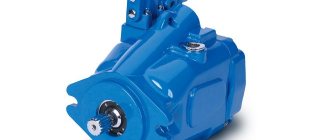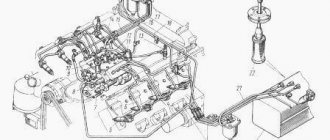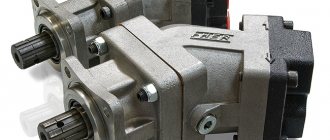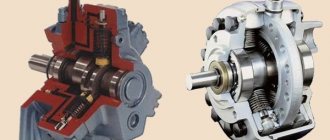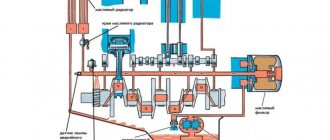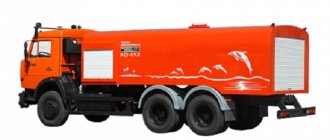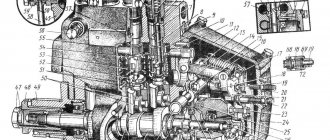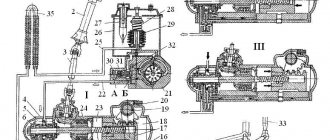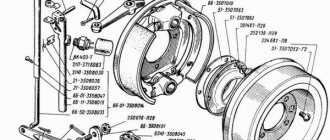Vacuum pump used for pumping out sewerage
If the site has an autonomous sewer system, it must be cleaned regularly. Failure to carry out this procedure in a timely manner leads to the fact that sanitary conditions on the site begin to deteriorate, and the cesspool or septic tank overflows. Subsequently, it will be much more difficult to maintain the sewer. To quickly and effectively pump out sewage, you should call a sewer truck, which is equipped with all the necessary equipment. The main element that is involved in the pumping process is the vacuum pump. With its help, the machine is able to clean the drainage structure in a few minutes.
How often to pump out a septic tank: we understand the main factors
From this article you will learn
:
The first question for the owner of a private house without a centralized sewerage system is how often to pump out the septic tank. Unfortunately, there is no single answer to this; it all depends on the model and the general design of the autonomous sewage system. A simple cesspool requires a different pumping frequency than modern sewage treatment systems.
Methods for removing contaminants are no less important. You can turn to the services of specialists or carry out the work yourself by purchasing the necessary equipment. In our article we will tell you what factors influence the frequency of pumping the septic tank, how to arrange it and what to do after removing the contaminants.
Principle of operation
A vacuum pump for sewerage is used to work together with other equipment that is equipped with a sewer truck . With its help, the contents begin to be pumped into a special tank, after which it is delivered to the place of its disposal.
The principle of operation of a vacuum pump is that a vacuum is created in the working chamber in a fairly short period of time. When such a vacuum reaches the required value, the pumped substance (wastewater, sewage, steam) begins to flow into the storage tank. This type of equipment is recognized as the most effective for such work.
Malfunctions and their elimination on the GAZ 3307/09 sewer truck
In the first article about this specialized transport, we touched upon the topic of the operating features of the main unit of special equipment - the vacuum pump. We introduced our readers to what procedures must be performed during daily inspection in order for this unit to serve for a long time and properly. Continuing the discussed topic of servicing a sewer truck based on the GAZ 3307/09, in today’s article we will talk about what the main faults are inherent in the KO 503 brand pump (installed on this model of a sewer truck) and how to deal with these faults.
What is a sewer machine
When considering vacuum pumps that are installed on sludge-suction machines, it is necessary to explain what a sewer machine used for pumping sewage .
This is a set of equipment that pumps out sewage and wastewater from cesspools, septic tanks, reservoirs, and settling tanks. After this, the machine delivers the contents to special disposal sites, where it unloads the waste. The sewer truck consists of the following important elements:
- storage tank, which is a cylindrical steel tank with a slight slope to make unloading convenient;
- a receiving hatch having a suction hose;
- additional electrical equipment;
- a signaling and safety device that helps prevent the tank from overfilling and signals the operator about it;
- valve controlling the pipeline;
- Vacuum pump.
This sewer pumping machine works as follows. First turn on the engine. The suction hose is then immersed in a container containing the contents that need to be pumped out. The vacuum pump starts working, which helps create a vacuum in the tank. The container gradually fills with sewage. As soon as it is completely filled, a safety device is activated, which turns off the engine. After arriving at a special location, the tank is emptied by air pressure in the pump or by gravity.
Types of vacuum pumps
- High vacuum pump - used when working with low pressure. Basically, two pumps are used, which are connected one behind the other.
- A low-vacuum pump helps reduce the pressure of the pumped waste. This device typically produces pressure that is characteristic of a low vacuum.
- Forevacuum pump - required to obtain a high level of vacuum. It creates the necessary conditions for the operation of a pump with a higher vacuum level. This pump significantly saves energy.
- The booster pump creates a medium vacuum in the system. It is usually installed between fore-vacuum and high-vacuum equipment.
- The pre-vacuum pump is used to reduce the pressure of the contents from atmospheric level to a pressure at which another vacuum pump will operate without problems.
Main characteristics of vacuum pumps
Such a device used for pumping sewerage must have the following characteristics:
- Pumping speed . This parameter determines how much content is downloaded per unit of time.
- Maximum starting pressure . This characteristic determines the maximum inlet pressure at which pumping is carried out.
- Ultimate outlet pressure . It represents the pressure at the outlet of the equipment when the pump is still pumping out the substance at rated speed.
- Steam pumping device performance . During operation, the amount of vapor is counted in weight units.
- Maximum residual pressure . Represents the highest value of steam pressure at the pump inlet. This indicator is taken into account when pumping out steam.
- Pump compression ratio . This parameter is characterized by the ratio of the volume of gas that is compressed during its compression.
Features of operating pumps for pumping out sewerage
When operating vacuum equipment, you need to adhere to certain conditions, thanks to which it will operate uninterruptedly for quite a long time.
In order for the device to work flawlessly, it is necessary to use new oil, which should be used to flush its lubrication system. It is prohibited to use used oil for this purpose.
The pump must always be clean. Existing contaminants significantly impair its performance , which can lead to its breakdown. It is necessary to monitor oil consumption at all times to ensure that the minimum level is not reached. The pump must not be operated without stopping for more than one hour.
To determine the direction of rotation, you must pay attention to the pump body, where the corresponding arrow is located. Pumps with right-hand torsion are used for installation on diesel vehicles. But on carburetor cars, pumps with left-hand rotation are installed.
Types of faults and their elimination
Malfunctions of vacuum equipment can be the following:
- tight rotary rotation - it is necessary to disassemble the structure, rinse thoroughly and reassemble;
- knocking in the pump - the body part, blades or bearings are being replaced;
- interruptions due to oil supply - it is necessary to tighten the connecting fasteners and perform air purging of the dropper;
- drop in throughput - replace worn parts;
- overheating of the housing - fill the system with lubricant, disassemble the equipment, wash the parts, clean the pipeline;
- weak pump vacuum - tighten the connecting fasteners, remove the rotor and wash the parts, check the height of the blades.
Equipment properties
The list of main properties includes the following:
- power consumption – 6 kW;
- output – 240 m³/h;
- indicated number of revolutions – 1450 rpm;
- direction of rotor torsion – left, right;
- maximum vacuum – 0.085 MPa;
- ultimate compression – 0.06 MPa;
- maximum temperature conditions of the equipment – 80 °C;
- efficiency factor – 0.8-0.9;
- weight – 90 kg.
- length – 47 cm;
- width – 28 cm;
- height – 22.5 cm.
Possible faults
Possible malfunctions may include the following:
- tight rotary rotation;
- drop in throughput;
- knocking on the pump;
- case overheating;
- interruptions in oil supply;
- low pump vacuum.
There are several main reasons that lead to malfunctions.
Stiff rotor rotation occurs due to inaccurate assembly of the pump. A drop in throughput occurs due to worn out or dirty rotor blades.
A knock in the pump indicates that the bearings are worn out, the blades are sunken, the inner side of the body has been subjected to mechanical impact from blades up to 0.2 cm deep, while the standard height of the blades is 3.7 cm.
Overheating of the housing occurs due to lack of lubrication or contamination of the pumping unit.
Interruptions in oil supply , as a rule, indicate that air is being sucked into the connecting fasteners or dirt has entered.
Methods to eliminate the above reasons may be as follows:
- with tight rotary rotation, the pump must be disassembled, washed and reassembled;
- the drop in throughput can be eliminated by replacing worn parts; in case of jamming, wash the parts;
- if a knock is detected in the pump, you need to replace the bearings, blades or casing;
- overheating of the housing indicates the need to fill the system with lubricant, disassemble the equipment, wash parts, clean the pipeline;
- if there are interruptions in the oil supply, tighten the connecting fasteners and bleed the dropper with air;
- in the case of weak pump vacuum, you need to tighten the connecting fasteners, remove the rotor and wash the parts, check the height of the blades.
Vacuum pump for pumping out sewerage
The presence of an autonomous sewage system requires its regular cleaning. If this procedure is not carried out on time, then the sanitary conditions on the site will deteriorate, the septic tank or cesspool will be overfilled. And then it will be even more difficult to maintain individual sewage systems. A summoned sewage disposal truck equipped with appropriate equipment will help you pump out sewage quickly and efficiently. The main element involved in the pumping process is a vacuum pump for pumping out sewerage. With its help, the machine will clean your drainage structure in literally a matter of minutes.
Ways to check the sediment level in a septic tank
How do you know when your septic tank needs to be pumped? To do this, determine the level of sediment in the tank. This can be done using a long wooden stick. We lower it through the hatch to remove the solid fraction into the container; the stick should reach the bottom. Then we take it out and determine the level of sludge. Before doing this work, you should find out how deep the septic tank is.
There is no need to pump out the septic tank if the sediment level is less than one-third of the depth of the tank. When the level is located 10 cm below the outlet pipe, the sewer system cannot be used until the septic tank is cleaned.
If the tank overfills within a short time, it is necessary to check the condition of the drainage layer. To do this, you need to pump out the wastewater, remove the sediment, and then remove the filter element layer. It can no longer be used and needs to be replaced. Then you will have to remove 10–15 cm of soil located under the drainage. Instead, a layer of sand is laid, and crushed stone is poured on top.
If the filter element fails, it is not recommended to use special chemicals for cleaning. Their use will be ineffective. The maximum you can achieve with their help is to extend the life of the septic tank by 30–60 days. In addition, these chemicals will pollute groundwater and kill colonies of bacteria living in the ground.
Purpose and operation of a vacuum pump
The vacuum pump for sewerage is designed to work in conjunction with other equipment installed on a sewer truck. With its help, the contents are pumped into a special tank, in which it is transported to the disposal site. The principle of operation of a vacuum pump is to create a vacuum in the working chamber in a short period of time . As soon as such a vacuum reaches the required value, the pumped-out substance (sewage, wastewater, steam) is sent to a storage tank. This type of pump is considered the most efficient in operation and safe for the environment.
How does a vacuum cleaner work?
Vacuum trucks are often used to pump out sewage. They are vehicles based on KamAZ, GAZ, ZIL vehicles or other trucks of suitable power. A distinctive feature of such cars is a special tank on the body, into which human or animal waste is pumped. The process of pumping sewage occurs thanks to a pump installed on the machine.
However, not every unit is suitable for installation on a sewer truck. An ordinary circular pump is not suitable for these purposes due to the extreme specificity of sewage drains, which are filled with all sorts of impurities that clog the active zone of the pump, causing it to quickly fail. Such machines require another device that should not directly interact with water.
What is a sewage disposal machine?
Since we are looking at pumps installed on sludge sucking machines, let us explain what a sewer pump is. This is a set of wheeled equipment that pumps out wastewater or sewage from cesspools, reservoirs, septic tanks, and settling tanks. After pumping out, the machine delivers the contents to disposal sites, where it unloads the sewage.
A typical sewer truck consists of the following main elements:
- storage tank. This is a steel cylindrical tank with a slight slope for ease of unloading;
- Vacuum pump;
- signaling and safety device. Its presence prevents the tank from overflowing and alerts the operator;
- receiving hatch with suction hose;
- pipeline control valve;
- additional electrical equipment.
Sludge pumping machine for sewer pumping KO 505A
The vacuum sewer pumping machine works on the following principle. All equipment is powered by a running engine. The suction hose is immersed in a container with the contents to be pumped out. The vacuum pump is turned on, creating a vacuum in the tank. The tank is filled with sewage. Once it is completely filled, a safety device is activated, shutting off the engine. After arriving at the unloading site, the tank is emptied by gravity or due to air pressure in the pump.
Advice: When calling a sewer truck to your site, ensure that it can easily travel to the pumping site.
Operating principle and purpose
The operating principle of a vacuum machine is simple - the vacuum pump is activated by a running car engine.
Diagram of a vacuum pump for a GAZ sewer truck
The pump creates the necessary vacuum in the tank, and liquid is captured through the pipeline. The tank is filled until the maximum level is reached.
When the level is reached, an audible signal sounds and the pump stops automatically. Automatic stopping is ensured by a signaling and safety device - there is a special level sensor in the barrel. The contents of the barrel are drained by gravity.
The intake hose is connected to the system (intake hatch) using a union nut; at the other end of the hose there is a metal tip, which is lowered into a pond or cesspool.
Types of vacuum pumps
- a high-vacuum pump will be useful when working with low pressures. Typically, 2 pumps connected in series are used;
- a low-vacuum pump reduces the pressure of the pumped waste. The device also creates pressure inherent in low vacuum;
- a fore-vacuum pump is used to obtain a high level of vacuum in the system. It provides conditions for the pump to operate at a higher vacuum level. The pump saves energy;
- The booster pump creates a medium vacuum in the system. It is usually installed between the foreline pump and its high-vacuum analogue;
- a pre-vacuum pump can be used to reduce the pressure of the contents, ranging from atmospheric level to a pressure at which another vacuum pump will operate normally.
How to diagnose a vacuum device
First, the system is turned off, this is a prerequisite.
Check the tightness of the unit and its correct operation. Then a thorough inspection of each joint is carried out. The degree of contamination is revealed:
It is mandatory to check water supply systems to see if there is water in the well.
It becomes obvious that only specialists can effectively service vacuum pumps. Of course, you can even replace the service kit yourself. However, before and after this, it is recommended to diagnose the unit. After all, other malfunctions may appear.
You need to understand that it is much more profitable to prevent breakdowns than to correct them. And this is only possible with timely maintenance.
Usually, not very serious malfunctions of the vacuum pump are detected, which can be completely eliminated. But sometimes the entire system has to be changed, although such cases are rare.
Source
Main characteristics of pumps
Parameters characterizing the operation of a certain model of vacuum pump for pumping out sewerage:
- pumping speed. This is the amount of contents pumped out per unit of time. Determined in the inlet section of the receiving pipeline;
- maximum starting pressure. This parameter characterizes the maximum inlet pressure at which pumping will begin;
- maximum outlet pressure. This is an indicator of the pressure at the outlet of the equipment when the pump will still be able to pump out the substance at the rated speed;
- steam pumping device performance. In the process of pumping out liquid, the amount of vapor is calculated in weight units;
- maximum residual pressure. This is the theoretical value to which the operating pressure approaches under standard conditions;
- steam pressure is maximum. This is the highest value of steam pressure at the pump inlet. This indicator is taken into account when pumping steam;
- pump compression ratio. The indicator characterizes the ratio of the volume of gas compressed during its compression.
Vacuum pumps for sludge sucker
Self-pumping of the septic tank
In some cases, you can pump out the septic tank yourself without calling a sewer truck. To do this work, you will have to buy a submersible fecal pump with a cutting impeller or grinder.
It is prohibited to use a pump designed for pumping clean or drainage water to remove solid sediment. You won't be able to clean the septic tank with it; you'll simply break the equipment.
Most often, waste is pumped out during the first frost in the fall. This is necessary to prevent the unpleasant odor from spreading to neighboring areas. If it gets colder outside, it will be more comfortable to do this work.
You should choose a fecal pump model taking into account the required power and pressure, as well as the amount you have available. The cost of budget pumps with a chopper is about 5,000 rubles.
This fecal pump has the following parameters: electric motor power - 250 W, maximum pressure - up to 7 m, size of solids removed - up to 3.5 cm. The pump has a float switch, as well as automatic shutdown if the device overheats. It is important that the outlet to which it will be connected is grounded. It must be connected via an RCD, the response current is 30 mA.
Features of operation of vacuum equipment
During the operation of vacuum equipment, it is necessary to observe certain conditions, thanks to which the equipment will operate properly for a long time:
- For perfect operation of the device, it is necessary to flush its lubrication system with new oil. Use of used oil is not allowed;
- the pump must be kept clean. The presence of contaminants can impair its performance and even lead to failure of the device;
- It is necessary to constantly monitor oil consumption, preventing it from reaching the minimum level. Average oil consumption is about 90 g/h;
- It is unacceptable to operate the pump without stopping for more than 1 hour;
- To determine the direction of rotation, you need to pay attention to the pump body, where the corresponding arrow is located. Pumps with right-hand rotation are purchased for installation on diesel vehicles. At the same time, pumps with left-hand rotation are installed on carburetor cars.
In our review article we talked about Grundfos sewage pumps with examples of popular models.
Read about plastic containers for sewage needs here.
You can read about how to choose a sewer system for a country house on this page of the site.
Pump KO-510
The pump of this brand is suitable for machines with left-hand and right-hand rotation such as KO-510, 520, 523. In addition, such pumps are mounted on the basis of GAZ, ZIL, KAMAZ, MAZ, URAL.
This combination allows for manipulations with capacitive compression at operating temperatures from -20 to +40 °C. The arrow shown on the body makes it possible to determine the rotation of the pump.
The operating principle of the equipment is still based on the injection of air, as well as the generation of a capacitive vacuum inside. This is how sewage is dumped and pumped inside.
Two marking types of pumping equipment are standardly produced: KO-510 0216000-04 – right-hand torsion pump, and KO-510 0216000-05 – left-hand torsion pump.
Popular vacuum pump models
KO-503
This is a vacuum pump that operates fully at temperatures of -20+40 degrees. The pump body is cast iron. The cover is equipped with bearings that allow rotary rotation. The housing has holes for introducing lubricant. Lubricant comes from a nearby tank. This vacuum pump is installed on a GAZ 53 or GAZ 3309 sewer truck. Model KO-503 0214100 is designed for left-hand rotation, and the designation KO-503 0214100-02 indicates that the pump has right-hand rotation.
- Efficiency - 0.8-0.9;
- power - 6 kW;
- speed - 1450 per minute;
- pump capacity - 240 cubic meters/hour;
- rotary torsion - right and left are allowed;
- dimensions - 470 x 225 x 280 mm;
- weight - 90 kg.
Model KO-503
This pump is mounted on a sewer truck, which allows you to pump out sewage. For a diesel car, it is necessary to purchase equipment with right-hand rotary rotation.
Whereas a carburetor machine should be equipped with equipment with left-hand rotation.
To determine the direction of rotation, you need to look at the arrow shown on the body. In addition, if you look from the end side of the shaft, if it twists clockwise, this will mean that the torsion is right-handed, but if it’s the other way around, then it’s left-handed.
The tanks used are usually mounted on the GAZ-3309, 53 base.
In addition, the pump is used in PCF-3, PCF-4 tanks, which allows you to pump out or pump sewage inside. When using the equipment you must:
- guarantee the adjusted oil supply using the pump lubrication system;
- replace worn blades in a timely manner;
- Do not allow the pump to operate non-stop for more than 60 minutes.
The pump parameters allow it to operate in the temperature range from -20 to +40°C. Thanks to the vacuum created by the pump, the container is filled or emptied.
It should be noted that the pump body is made of cast iron. It is covered with caps with bearings that actually allow rotary rotation.
Blades are mounted in the rotor grooves. The pump body also has holes through which the equipment is lubricated.
In addition, an oil tank is attached to the frame, from where lubricant in the required volume, regulated by special screws, is supplied to lubricate the parts.
Types of vacuum pumps for sewage disposal machines
Depending on the operating conditions of the unit, there are different types of pumps.
Based on design features, they are divided into the following types:
- steam-oil type. This type of unit uses oil to clean the system;
- water ring type. Such devices use water during operation. Used in the agricultural and chemical industries;
- membranous appearance. Devices of this type use the principle of compressed air energy when operating. Used for cleaning medical, chemical, and printing equipment;
- rotary-plate type. Pumping occurs due to retractable blades. Used in metallurgy.
Vacuum pump equipment for a sewage disposal machine
Depending on the pressure created, they are divided into:
- booster look. Features high pumping speed. This type balances the outgoing and incoming pressure of high-vacuum and fore-vacuum pumps. Installed between them;
- high vacuum. To obtain indicators, steam-oil mixtures are used. Used when working with low pressure. This type consists of two connected blowers;
- Forevacuum type. To obtain the fore-vacuum range, mechanical blowers are used;
- low vacuum type. To achieve fore-vacuum performance, a pressure below one torr is required. Used to lower blood pressure;
- pre-sparse view. To achieve pre-rarefied performance, a rotary vane supercharger is required. It is used when the pressure in the pumped-out volume decreases, to enable operation of another vacuum apparatus.
The cost of pumping a septic tank from sewer trucks
If you plan to hire professionals to pump out your septic tank, you should tell them how big the tank is and where it is located. This information is necessary for the vacuum cleaners to select a machine with a tank of the required volume from 4 to 15 cubic meters, and also use a hose of the required length.
Important!
The hose length in a standard sewer truck is 15 m; it is possible to attach additional 5-meter hoses. Typically, cars are equipped with pumps capable of pumping out hoses up to 15 m. For a longer distance, a more powerful pump will be required. Today, a new generation of equipment has emerged that has advanced capabilities and is capable of pumping over a distance of a hundred meters or more.
Construction of a sewage disposal machine
The machine is a mechanism for cleaning sewers, cesspools, and settling tanks. Consists of the following parts:
- Vacuum pump;
- reservoir for accumulation of substances. It is a large-volume metal tank placed at a slight angle. This is due to the convenience of unloading substances;
- signaling mechanism. Necessary to prevent tank overfilling;
- hatch with a hose for receiving liquid;
- valve for controlling the hose.
Principle of operation
The operating principle of the machine is as follows:
- The process occurs due to the car engine. The suction pipe is placed into the substance to be pumped out.
- The vacuum pump on the sewer truck turns on. After starting work, a vacuum forms in the container.
- When the tank is filled, a shut-off mechanism prevents the tank from overflowing.
- After moving to the disposal point, the tank is released using pump pressure.
Operating principle of KOKS MegaVac vacuum machines (video)
Application of machines
Vacuum pumps for sewer trucks are used to pump waste from cesspools and sewer networks. When repairing a water supply system, flushing pipes, water is pumped out to gain access to the object being repaired.
The vacuum pump for the sewer truck is used by housing and communal services and private companies. The operating temperature of the mechanisms for the sewer cleaning machine ranges from minus twenty to plus forty degrees Celsius.
Operating principle of sewer washing machine pumps
A vacuum pump for sewer cleaning machines is used in conjunction with equipment for a sewer cleaning machine. The pump pumps the substance into a specialized container. After which it is transported and disposed of.
A vacuum occurs in the chamber of the device over a short period of time. Upon reaching the required vacuum, the pumped mixture enters the container.
Characteristics of sewage pumps
Mechanisms for pumping out sewage have the following characteristics:
Equipment for the vacuum cleaner machine
- Starting pressure. Determines pressure indicators to start pumping.
- Pumping speed. Characterizes the amount of substance pumped out over a period of time.
- Outlet pressure. Determines the pressure indicator at the outlet of the equipment when the unit continues to pump out.
- Steam pumping performance. This indicator determines the amount of vapor being pumped out.
- Residual pressure indicator. Important when pumping out steam. Shows the maximum pressure at the inlet of the unit.
- The compression ratio of the device. Shows the degree of volume compression during compression.
Operating conditions for vacuum cleaner devices
For uninterrupted and high-quality operation of the devices, you should adhere to the operating rules.
- The lubrication system is washed with new high-quality oil. Used oil is not used due to operational irregularities.
- Vacuum pumps for sewer trucks are kept clean. If there is contamination, the unit will malfunction and break down.
- The oil volume must be at the required level. When the oil level is minimal, the operating mode is disrupted.
- Operation of the unit should not exceed one hour of continuous operation.
Before purchasing, you should familiarize yourself with the compatibility of the device with the type of car engine. Diesel engines are compatible with right-hand drive pumps. Carburetor-type vehicles are compatible with left-hand drive.
During operation, breakdowns of the units are possible.
Pump operation
The process of using the pump requires compliance with certain conditions. In particular, it is necessary:
- keep the pump clean;
- carry out systematic flushing of the lubrication system, while filling it exclusively with purified oil;
- control oil consumption. The basic operating mode of the equipment requires an average of 90 g/hour.
Attention! The use of processed oils is prohibited. Non-stop operation of pumping equipment for more than 60 minutes is not allowed!
Vacuum pump for sewer truck
A sewage disposal machine is used to clean cesspools in an autonomous sewer system or remove blockages in centralized systems. This technique helps keep communications in working order and in accordance with sanitary and hygienic requirements. The main working element is the vacuum pump for the sewer truck. It operates on the principles of differential pressure. Using the properties of a vacuum, it pumps out the contents of the sewer.
During the process, the pump does not interact with liquids; they pass through the hose. The system operates under heavy loads, so the sewer tank is made of durable, mechanically resistant materials. There are many types of pumps, mainly they differ in their ability to work with liquids of different degrees of contamination. But before you start pumping using any of the models, you must first prepare the environment, since a sudden creation of vacuum pressure can cause the device to malfunction. The sewer truck consists of the following modules:
- tank for collecting and transporting sewer liquids;
- Vacuum pump;
- a device that controls the filling of the tank;
- hose tap;
- hatch and hose for receiving waste.
Differences between a septic tank and a cesspool
The septic tank is designed to disinfect wastewater and drain water after filtration. At the same time, solid particles constitute a small amount of the total volume of waste.
In the cesspool, solids are mixed with liquid. But in a septic tank, the wastewater is separated into two parts: water and solid waste. The liquid part goes through cleaning, continuously being removed from the tank. The sludge precipitates, accumulating at the bottom of the container.
It is for this reason that you do not need to pump out a septic tank as often as a cesspool.
What is the difference between these two methods of organizing a sewer system?
A cesspool is a storage tank completely buried in the soil. If this tank is completely impervious to water, after a short period of time it will overflow: wastewater will begin to pour out of it.
To prevent this from happening, the side walls, as well as the bottom of the tank, must allow water to pass through. In this case, solid particles accumulate at the bottom, and liquid seeps into the ground.
As soon as the cesspool overflows, you will have to call a sewer truck to pump out the waste.
Scope of application of pumps
A sewer truck is a vehicle equipped with an installation for pumping liquid from sewers, mainly based on domestic trucks. A tank is installed on the car into which waste is pumped. Inside there is a vacuum pump for a GAZ, KAMAZ, ZIL or URAL sewer truck. Special equipment is used to solve the following tasks:
- pumping waste from cesspools;
- clearing clogged sewer lines;
- pumping out liquid for access to the repair area of engineering systems;
- flushing of pipelines for various purposes.
This special equipment is capable of operating in a wide temperature range: from -20 to +40 degrees C. The machines are used by housing and communal services and private enterprises providing specialized services. More often than other models, a vacuum pump is used for the GAZ 53, GAZ 3309 and GAZ 3307 sewer trucks.
Pump KO-505A
This pump serves to generate capacitive air injection and excess intracapacitive pressure.
The equipment is mounted on the basis of ZIL, MAZ, KAMAZ, URAL. The operating temperature of the KO-505 pump is from -20 to +40 °C. Filling and emptying of containers occurs due to the discharge of the pump.
The frame of the pump is made of cast iron, which is closed using lids. These covers contain bearings, due to which rotary rotation occurs.
The rotor grooves contain built-in textolite blades. The pump is also equipped with a lubrication system, which ensures forced lubrication of the equipment, so before starting operation it is necessary to adjust the oil flow.
Pump parameters
The list of main properties includes the following:
- power consumption – 9 kW;
- output – 310 m³/h;
- indicated number of revolutions – 1150 rpm;
- direction of rotor torsion – left, right;
- maximum vacuum – 0.085 MPa;
- ultimate compression – 0.06 MPa;
- maximum temperature conditions of the equipment – 80 °C;
- efficiency factor – 0.8-0.9;
- weight – 110 kg;
Dimensions:
- length – 52 cm;
- width – 30 cm;
- height – 29 cm;
Cost – 12 thousand 900 rubles.
Types of vacuum pumps
Two classifications apply to devices. According to their design, vacuum pumps for sewer trucks are divided into the following types:
- steam oil pumps use oil;
- membrane models operate on the principle of compressed air energy;
- water ring devices use water;
- The rotary vane type operates using retractable vanes.
The pump for the GAZ, URAL and other models of sewer trucks are also classified according to the parameters of the pressure created:
- booster pumps pump out liquids at high speed, balancing incoming and outgoing pressure, installed between the fore-vacuum and high-vacuum devices;
- high-vacuum modifications operate with low pressure, they use steam-oil mixtures; such a vacuum pump for a sewer truck has two connected superchargers;
- fore-vacuum devices form the appropriate range using mechanical blowers;
- low-vacuum type is used for low-pressure systems;
- Pre-discharge pumps are designed for operating situations in which it is necessary to reduce the pressure in the pumped medium to values that can be handled by another vacuum pump.
Specifications
So that special equipment can effectively perform tasks, and operators do not complain to management that the pump on a sewage disposal machine does not pump well, it is important to pay attention to the following technical parameters of the pump:
- unit rotation speed;
- pumping speed;
- dimensions;
- starting pressure;
- outlet pressure;
- maximum vacuum pressure values;
- device compression ratio;
- residual pressure values;
- performance;
- weight.
Features of operation
To maintain the functionality and efficiency of the sewer machine, you should follow the following rules:
- before starting work, it is necessary to check the technical condition of the device;
- lower the hose into the sewer system;
- open the oil supply valve;
- turn on the pump;
- Upon completion of pumping, perform the same operations in reverse order.
“Always use high-quality new oil during operation, otherwise the pump will malfunction.”
The vacuum pump must be kept clean, since contamination is one of the common causes of breakdowns. Personnel must constantly monitor the oil level; with a minimum volume, the operating mode of the mechanism is disrupted. Most vacuum pumps can only run continuously for 1 hour before taking a break, as recommended by the pump manufacturer. It is advisable to regularly maintain the pump; this will extend its service life while maintaining its technical characteristics.
Popular modifications
Vacuum pumps for sewerage work have been used since the 30s of the last century. Today's pumps are critically different from their predecessors, both in capabilities and design. In the Russian Federation, three models are mainly used:
- The vacuum pump KO 503 for a sewer truck has been used since the 50s of the last century, it has been tested in operation and has proven itself to be excellent. made in a cast iron body, the rotor moves to the right, is capable of pumping 250 m3/hour, maximum pressure - 6 nPa;
- model KO 505A is an improved version of the previous pump, with the same maximum pressure it is characterized by higher operational parameters, when working with it it is important to pay attention to work safety;
- the KO 510 device is the most advanced modification, its rotor can rotate in both directions, that is, the pump can be installed on a car with any engine, the pump creates the same pressure, but the efficiency and performance are much higher.
Repair features
...pump with float
The float type pump can be repaired with your own hands. Certain steps must be followed.
1. Turn the pump over so that the impeller is on top, remove the protective mesh, which is available on many models. Unscrew a couple of nuts on the edges of the housing to free the wheel.
Attention! In some models of units, the protective box is attached using clips or using the threaded method.
2.Remove the impeller. Unscrew the clamping nut on the rod in a clockwise direction. The rod has a recess for a screwdriver. You need to lubricate the threads in advance with oil or aerosols. When the locknut is unscrewed, a problem arises: the impeller is rusty. You need to tap the rod lightly to release the disc.
3. The cause of the breakdown has not been found, we need to look further. Bolts for clamping are installed on the top of the body. If you unscrew them, the device will separate into parts. On the one hand, there will be a lid, a float with a capacitor. On the other hand, there is a motor with a rod and shaft. The parts will be connected by wires. The cables have different colors and how they are located should be written down on paper to facilitate reassembly. The engine compartment is still closed. The motor is difficult to separate from the housing; you need to hit the rod to knock the motor out.
4.When the entire device is disassembled, it will become clear what the cause of the malfunction is. As a rule, the motor or bearings break.
Float device. When the main parts of the device have been disassembled, but serviceability has not been found, it is necessary to inspect the float mechanism with the capacitor. The float regulates turning the unit off and on when necessary, and protects against dry operation. It is necessary to disassemble the float device. To do this, unscrew the bolts on the housing using a screwdriver. There is a ball in the housing, with the help of which the engine is turned on. The valve may stick or become stuck.
How to repair a float. When replacing a part, you then need to reassemble the equipment in the reverse order. Before you start disassembling the device, you need to make sure it breaks several times.
Attention! When assembling the unit, the seal rings should be lubricated with engine oil.
Main causes of problems
All breakdowns are based on common causes. These include the following:
1. Violation of the operation of the unit. It is necessary to understand the differences between a drainage pump and a fecal pump, which are similar. You cannot pump out waste water with a drain. If you use the device incorrectly, it will break. If you frequently turn off and turn on the motor, the engine will burn out and the bearings will fly.
2. Problems with the cable. The main element of the pump is the electrical cable that supplies power. The cable may break or the cord may break, interrupting the power supply. You can replace the cable yourself; you need to correctly determine the diameter and number of cores.
Attention! If the cable breaks, the entire cord from the pump to the plug should be replaced.
3.Lack of timely maintenance. All units must be inspected in a timely manner for problems approximately once a year. If the pump is constantly in the water, it is taken out once every three months. During inspection, be sure to lubricate the bearings and check the bolts and nuts. If this is not done, the equipment may break.
4.The device operates dry. The equipment cannot operate if the liquid level is very low. The pump is connected to the network when lowered into the water. If no one is watching the pump while pumping water, the pump may not stop working in the absence of water. Then the motor heats up, the motor braid sticks together, which leads to a short circuit - complete combustion of the pump. This requires expensive repairs.
5.The medium for the pump is incorrectly determined. The pump cannot pump silt or clay. At first it will cope with the load, then it will stop functioning. The impeller may break due to small pebbles. The device will pull pebbles in, but will stop working when stones get caught in the crusher augers.
6.Pump is not installed correctly. The device is placed in a container, immersing the apparatus with a float deeply. Do not place the device on the bottom.
7. Defects during production. You cannot throw away receipts for the purchase of the unit so that you can change it.
8. The tightness of the structure is broken. When the device is immersed in water, it must be lowered smoothly and slowly. It can be hit against a wall or a stone, causing a crack to form in the body. Then water will pour inside and the motor will burn out.
Helpful Tips for Maintenance
Maintenance of pumping equipment requires compliance with certain nuances. After using the pump, it must be removed to the surface if the unit does not operate constantly. Before lowering the pump into the water, you need to turn it on and raise and lower the float several times to check the operation of the pump. When the device is taken out, do not pull it by the cord or hose. It is pulled out by tying a cable or rope to the handle. Only clarified water that does not contain clay or silt can be pumped out. It is necessary to clean the channels of the protection box in the impeller more often.
